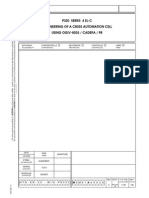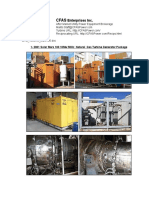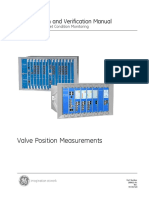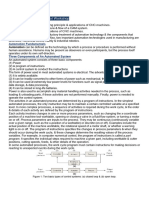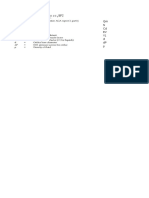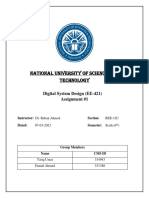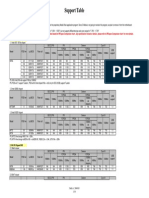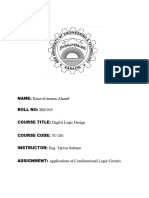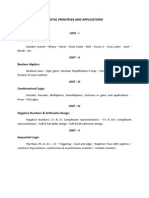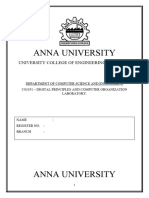GE Mark V Overview
GE Mark V Overview
Uploaded by
Brian QiCopyright:
Available Formats
GE Mark V Overview
GE Mark V Overview
Uploaded by
Brian QiOriginal Description:
Original Title
Copyright
Available Formats
Share this document
Did you find this document useful?
Is this content inappropriate?
Copyright:
Available Formats
GE Mark V Overview
GE Mark V Overview
Uploaded by
Brian QiCopyright:
Available Formats
Improved methods of implementing the triple-modular redundant system center on
SIFT technology and result in a more robust control. SIFT involves exchanging
information on the voter link directly between <R>, <S>, <T> and <C> controllers.
Each control processor measures all of its input sensors so that each sensor signal is
represented by a number in the controller. The sensor numbers to be voted are gathered
in a table of values. The basic SIFT concept brings one sensor of each kind into each of
<R>, <S> and <T>. If a sensor fails, the controller with the failed transducer initially
has a bad value. But it exchanges data with the other processors and when the voting
takes place, the bad value is rejected. Therefore, a SIFT-based system can tolerate one
failed transducer of each kind. In previous systems, one failed transducer was likely to
cause one processor to vote to trip.
A failure of a different kind of transducer on another controller could cause a turbine
trip. This does not happen with SIFT because the input data is exchanged and voted.
<C> is also connected to the voter link. It eavesdrops while all three sets of variables
are transmitted by the control processors and calculates the voted values for itself. If
there are any significant disagreements, <C> reports them to <I> for operator attention
and maintenance action. If one of the transducers has failed, its output will not be
correct and there will be a disagreement with the two correct values. <C> will then
diagnose that the transducer or parts immediately associated with it have failed and will
post an alarm to <I>.
Operator Interface Function:
- Unit control
- Generator control (load control)
- Alarm management
- Manual control
a. Preselect load set point
b. Inlet guide vane control
c. Isochronous control
d. Fuel stroke reference
e. Auxiliary control
f. Water wash
g. Mechanical over speed test
Data
a. Exhaust temperature
b. Lube oil temperature
c. Wheel space temperature
d. Generator temperature
e. Vibration
f. Timers and event counter
g. Emission control data
h. Logical status
2.2 Mark V Data Communication Networks
Figure 1. Mark V Network Communication
Information is communicated, shared, and acted upon in the Mark V Control System via three separate
networks :
- The one external network, the Stage Link, is the primary means of communication between the
Operator Interface (<I>) and the common data processor (<C>) of the control panel.
- The data exchange network (DENET) is an ARCNET type communication network internal to the
Mark V control panel. The function of the DENET is to provide a communication link between the
internal processors of the control panel.
You might also like
- Tda Little Book of ChangeDocument40 pagesTda Little Book of ChangeBrian Qi50% (2)
- Tda Little Book of ChangeDocument40 pagesTda Little Book of ChangeBrian Qi50% (2)
- Sistema Electronico 140H TransDocument10 pagesSistema Electronico 140H TransRodolfo Acosta Martinez100% (8)
- D 100017 X 012Document24 pagesD 100017 X 012ErnestoNo ratings yet
- Geh 6759 PDFDocument172 pagesGeh 6759 PDFHung NgoNo ratings yet
- Maintenance Guide HA-20,22, VETDocument43 pagesMaintenance Guide HA-20,22, VETAyaovi Jorlau75% (8)
- 9e ChinaDocument7 pages9e Chinanabil160874No ratings yet
- Ansaldo EnergiaDocument15 pagesAnsaldo EnergiaWathik AbmNo ratings yet
- GT 6B Gas Fuel Inlet Pressure 96FG-2ABC False Indication - Automation & Control Engineering Forum PDFDocument1 pageGT 6B Gas Fuel Inlet Pressure 96FG-2ABC False Indication - Automation & Control Engineering Forum PDFnboulegrouneNo ratings yet
- 6 1Document19 pages6 1Zubair AhmedNo ratings yet
- Maintenance Working Hours Flow For Gas TurbineDocument7 pagesMaintenance Working Hours Flow For Gas TurbineHilmi HanoinNo ratings yet
- Cable Trays RequirementDocument1 pageCable Trays RequirementSulaiman JafferyNo ratings yet
- Tender Document GE MARK V HMIDocument16 pagesTender Document GE MARK V HMIabudimazNo ratings yet
- NIC 12.02 - Rev.01 Axial Displacement Inspection Procedure For Axial Andcentrifugal Compressors PDFDocument29 pagesNIC 12.02 - Rev.01 Axial Displacement Inspection Procedure For Axial Andcentrifugal Compressors PDFDjaber ElhaicharNo ratings yet
- Turbo C and C++Document195 pagesTurbo C and C++Bryan BejecNo ratings yet
- FST DFS GE Mark IV SpeedtronicDocument8 pagesFST DFS GE Mark IV Speedtronicnabil160874No ratings yet
- IntroDocument24 pagesIntronabil1608740% (1)
- Combustion Tuning For Combustion Turbines - NAES PDFDocument7 pagesCombustion Tuning For Combustion Turbines - NAES PDF82540100% (1)
- Ansaldo SFC With High Generator Voltage - Automation & Control Engineering ForumDocument1 pageAnsaldo SFC With High Generator Voltage - Automation & Control Engineering ForumHBNBILNo ratings yet
- Vibration: GE Power & WaterDocument14 pagesVibration: GE Power & WaterkatibraNo ratings yet
- The Terminology Guide For ChromatographersDocument84 pagesThe Terminology Guide For Chromatographersrichos100% (1)
- Turbine Modification of Nuovo Pignone Gas TurbineDocument4 pagesTurbine Modification of Nuovo Pignone Gas Turbinecaballero95250100% (1)
- Performance of Industrial GasturbinesDocument28 pagesPerformance of Industrial Gasturbinessomporn duangbuntaoNo ratings yet
- C80-35 Engineer PDFDocument151 pagesC80-35 Engineer PDFteutashNo ratings yet
- IC-000113Document23 pagesIC-000113hiralronny100% (1)
- Prismic A30Document2 pagesPrismic A30ario2481No ratings yet
- Engro - 9E Cofiring Field Testing Procedure - Rev1Document9 pagesEngro - 9E Cofiring Field Testing Procedure - Rev1Muhammad Younus ShahzadNo ratings yet
- What Is Excitation System - Definition & Types of Excitation System - Circuit GlobeDocument11 pagesWhat Is Excitation System - Definition & Types of Excitation System - Circuit GlobeSabaMannan123No ratings yet
- On Cooldown For Gas Turbine - Automation & Control Engineering ForumDocument1 pageOn Cooldown For Gas Turbine - Automation & Control Engineering Forumnboulegroune100% (1)
- Manual FSR ControlDocument2 pagesManual FSR ControlPremragunathan D (Instrumentation)No ratings yet
- Trnsmisor GultonDocument2 pagesTrnsmisor GultonINVERVENCA 2020No ratings yet
- Gap AppicationDocument4 pagesGap Appicationaqccc120100% (1)
- Plant Familiarisation: Unit 1 & 2Document6 pagesPlant Familiarisation: Unit 1 & 2Herbert H.No ratings yet
- 0201 MACH7 Hot Redundant PDFDocument8 pages0201 MACH7 Hot Redundant PDFSyed Mohammed HussainNo ratings yet
- Data Sheet - DCS Master P-5000 IO Test System PDFDocument12 pagesData Sheet - DCS Master P-5000 IO Test System PDFtriplbingaziNo ratings yet
- 1450RC Mars 100Document3 pages1450RC Mars 100Mr_UniversalNo ratings yet
- Lesson Mechanalysis - The Key To Machinery ConditionDocument13 pagesLesson Mechanalysis - The Key To Machinery Conditionmister pogiNo ratings yet
- Turbine Over SpeedDocument12 pagesTurbine Over SpeedjnmanivannanNo ratings yet
- G60A Test Checklist SiteDocument9 pagesG60A Test Checklist SitezakariaNo ratings yet
- CIBI of GT # 5 Frame VI at IOCL VadodaraDocument3 pagesCIBI of GT # 5 Frame VI at IOCL Vadodaramahesh_rathoreNo ratings yet
- Training MechanicalDocument2 pagesTraining Mechanicalmomo chanNo ratings yet
- Valve Position Measurements: Configuration and Verification ManualDocument63 pagesValve Position Measurements: Configuration and Verification ManualRabah Amidi100% (1)
- Mark V Control SystemDocument7 pagesMark V Control Systemأبو عبد الرحمن القاضى100% (1)
- 6B Transition Piece Product Sheet PDFDocument2 pages6B Transition Piece Product Sheet PDFkamran kainpor100% (1)
- Compressor Water Wash SystemDocument10 pagesCompressor Water Wash SystemCarlos GonzálezNo ratings yet
- DGU3073-Programmable Logic Controller-S7Document75 pagesDGU3073-Programmable Logic Controller-S7Aaron ChinNo ratings yet
- Lesson Introduction To Machinery and Noise: 1.0 What Is Vibration?Document34 pagesLesson Introduction To Machinery and Noise: 1.0 What Is Vibration?mister pogiNo ratings yet
- Journal BRG Vib & AnalysisDocument3 pagesJournal BRG Vib & Analysisbhupendra singh15No ratings yet
- Actuador Limitorque MX y QXDocument6 pagesActuador Limitorque MX y QXManuel FernizaNo ratings yet
- Performance Control of Gas TurbinesDocument2 pagesPerformance Control of Gas Turbinesmariasofiarossi100% (3)
- Steam Product CatalogDocument61 pagesSteam Product CatalogIan Jay TumulakNo ratings yet
- Wheelspace in Gas Turbine - Automation & Control Engineering ForumDocument1 pageWheelspace in Gas Turbine - Automation & Control Engineering ForumnboulegrouneNo ratings yet
- Vibration Analysis2Document59 pagesVibration Analysis2mister pogiNo ratings yet
- GEI-100271 System Database (SDB) Browser PDFDocument18 pagesGEI-100271 System Database (SDB) Browser PDFmeirangongNo ratings yet
- Water Cooled Check-Valves PDFDocument9 pagesWater Cooled Check-Valves PDFGeorge John Amegashie100% (1)
- D 0906-110-E000D - Released: Drawing Sheet & Revision Status Sheet No. Rev. Sym. Sheet No. Rev. Sym. Sheet No. Rev. SymDocument1 pageD 0906-110-E000D - Released: Drawing Sheet & Revision Status Sheet No. Rev. Sym. Sheet No. Rev. Sym. Sheet No. Rev. SymFerdinandjaNo ratings yet
- How To Access Excel Spreadsheets With Visual Basic 6Document25 pagesHow To Access Excel Spreadsheets With Visual Basic 6Wy Teay100% (1)
- A Vibration Based Condition Monitoring SystemDocument4 pagesA Vibration Based Condition Monitoring SystemkankokwahNo ratings yet
- Caterpillar 311b 330b Excavators Engine and Pump Electronic Control SystemDocument10 pagesCaterpillar 311b 330b Excavators Engine and Pump Electronic Control Systemjohn100% (61)
- Redundancy in Measurement SystemsDocument5 pagesRedundancy in Measurement SystemsSyed AhmadNo ratings yet
- Computer Numerical Control WorkshopDocument23 pagesComputer Numerical Control Workshopjojoahma7No ratings yet
- Control SystemsDocument9 pagesControl Systemsabednigo titusNo ratings yet
- Simulation of Some Power System, Control System and Power Electronics Case Studies Using Matlab and PowerWorld SimulatorFrom EverandSimulation of Some Power System, Control System and Power Electronics Case Studies Using Matlab and PowerWorld SimulatorNo ratings yet
- Remote Panelview Via VNCDocument6 pagesRemote Panelview Via VNCBrian QiNo ratings yet
- Flow Gas AGA3Document1 pageFlow Gas AGA3Brian QiNo ratings yet
- Vcmi ReplacementDocument1 pageVcmi ReplacementBrian QiNo ratings yet
- Introduction and Brief History of SCADADocument1 pageIntroduction and Brief History of SCADABrian QiNo ratings yet
- Standardgaz NPT: Nominal Diameter / Diamètre Nominal G Nominal Diameter / Diamètre Nominal NPTDocument1 pageStandardgaz NPT: Nominal Diameter / Diamètre Nominal G Nominal Diameter / Diamètre Nominal NPTBrian QiNo ratings yet
- ST Connector SpecDocument3 pagesST Connector SpecBrian QiNo ratings yet
- DL3500-DH+/MODBUS Communication Controller Application NoteDocument15 pagesDL3500-DH+/MODBUS Communication Controller Application NoteBrian QiNo ratings yet
- 2012 Vibronet Signalmaster Catalog enDocument48 pages2012 Vibronet Signalmaster Catalog enBrian QiNo ratings yet
- QCPU Programming Manual (Common Instruction) (SH - NA - 080809ENG-C) PDFDocument1,204 pagesQCPU Programming Manual (Common Instruction) (SH - NA - 080809ENG-C) PDFElectron-Iq PelGyNo ratings yet
- An Oracle JD Edwards Enterpriseone Performance and Tuning Paper 8/2007Document23 pagesAn Oracle JD Edwards Enterpriseone Performance and Tuning Paper 8/2007RaveRaveNo ratings yet
- ARM7 9 FamilyDocument46 pagesARM7 9 FamilySaravana KumarNo ratings yet
- GCSE OCR 1.1 Von Neumann ArchitectureDocument62 pagesGCSE OCR 1.1 Von Neumann ArchitectureMichael O’LearyNo ratings yet
- Siemens (s7 300)Document6 pagesSiemens (s7 300)imdebarshiNo ratings yet
- BIG-IP Virtual Edition and VMware ESXi Setup PDFDocument26 pagesBIG-IP Virtual Edition and VMware ESXi Setup PDFAurelio Canales AlcayagaNo ratings yet
- Technology: Vlsi Domain: Ieee Transactions OnDocument3 pagesTechnology: Vlsi Domain: Ieee Transactions Onnizam_shaikNo ratings yet
- W516 E1 02+CP1L ELEM - CPU+OperManual PDFDocument854 pagesW516 E1 02+CP1L ELEM - CPU+OperManual PDFAnonymous POne8dNo ratings yet
- BCA Second Semesters Model QuestionsDocument19 pagesBCA Second Semesters Model QuestionsNikit Kumar PaudelNo ratings yet
- CS 6290 Instruction Level ParallelismDocument45 pagesCS 6290 Instruction Level ParallelismTathagata Roy ChowdhuryNo ratings yet
- Introduction To Mips Assembly Language: Objective TheoryDocument5 pagesIntroduction To Mips Assembly Language: Objective TheoryTayyaba HussainNo ratings yet
- National University of Science and Technology: Digital System Design (EE-421) Assignment #1Document23 pagesNational University of Science and Technology: Digital System Design (EE-421) Assignment #1Tariq UmarNo ratings yet
- PCChips ServiceTableDocument10 pagesPCChips ServiceTablebrynsteinNo ratings yet
- SSDD DidDocument8 pagesSSDD Didlokgal08No ratings yet
- Dstni LX DS 01Document2 pagesDstni LX DS 01Rodrigo SilvaNo ratings yet
- Mobile Sniffer Cum Jammer With Alerting SystemDocument77 pagesMobile Sniffer Cum Jammer With Alerting System9fela100% (1)
- Clocked CmosDocument24 pagesClocked CmosAnil KumarNo ratings yet
- Module VDocument41 pagesModule VAryan JainNo ratings yet
- Instruction Sets: Addressing Modes and Formats: William Stallings, Computer Organization and Architecture, 9 EditionDocument31 pagesInstruction Sets: Addressing Modes and Formats: William Stallings, Computer Organization and Architecture, 9 EditionDang Hai Binh (K16HCM)No ratings yet
- Proper Ways of Taking Care of The Computer and Its HardwareDocument13 pagesProper Ways of Taking Care of The Computer and Its HardwareShane PagkaliwaganNo ratings yet
- Syllabus 3 Year (Effective From Session 2016-17) : Dr. A.P.J. Abdul Kalam Technical University Uttar Pradesh, LucknowDocument24 pagesSyllabus 3 Year (Effective From Session 2016-17) : Dr. A.P.J. Abdul Kalam Technical University Uttar Pradesh, LucknowAvnishNo ratings yet
- 3BSE015953R301 - en Advant Controller 450 Version 2.3 Product GuideDocument112 pages3BSE015953R301 - en Advant Controller 450 Version 2.3 Product GuideAFSHIN HaririNo ratings yet
- OS NotesDocument78 pagesOS NotesGRIMHEART REAPERNo ratings yet
- 301Document15 pages301Motor CsillagNo ratings yet
- Mobile Phone Repair: Power Intergrated Circuit ROMDocument2 pagesMobile Phone Repair: Power Intergrated Circuit ROMshalom fregeneNo ratings yet
- Application of Combinational CircuitsDocument6 pagesApplication of Combinational Circuitskanz ul emaanNo ratings yet
- Digital Principles and Applications: Unit - I Number RepresentationDocument3 pagesDigital Principles and Applications: Unit - I Number RepresentationvelsNo ratings yet
- CS3351 - DIGITAL PRINCIPLES AND COMPUTER ORGANIZATION LaboratoryDocument64 pagesCS3351 - DIGITAL PRINCIPLES AND COMPUTER ORGANIZATION Laboratoryparanjothi karthikNo ratings yet
- CE403 - Computer Organization and ArchitectureDocument4 pagesCE403 - Computer Organization and Architecturejon rey lumayagNo ratings yet






















